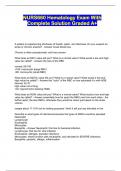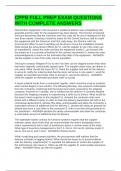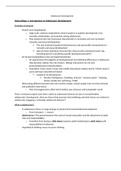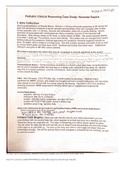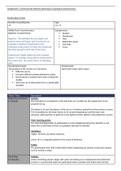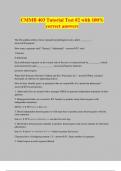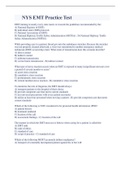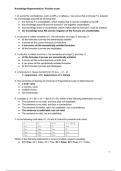Lecture 1
EXAM -> Closed BOEK & ONLINE
• Lectures: Pre-recorded videos
• Q&A: campus sessions
• Tutorials: on campus
• Workshops: online
Data collection? Questions to be asked during the 1st and 3rd tutorial
Process improvement & change in the field of operations and SCM: Dominant approaches
• Lean management
• Six sigma
• Total quality management
• Business process reengineering
They have some limitations despite their popularity.
• Other approaches can be more relevant to make improvements in the field of operations in
SCM
Improvement & change process
3 main stages in every improvement & change
process
1. Someone becoming aware of the need of change: identifying change opportunities
2. Diagnosing the change conditions: involves a deep analysis of the improvement opportunity
identified in the 1st stage.
a. the unit of analysis can be beyond the single company ( it might be the supply chain
that needs to change)
3. Change process & sub phases: the analysis of the need for change
a. it is different than the 1st stage where a person or a few people recognize the need
for change
b. Here we identify what we need to do (activities, communication) to move from the
current stage to the future state where the solution is implemented
Not (always) entirely consecutive
Alternative to an improvement & change process?
Two distinct aspects in any improvement or change situation need to be addressed:
• WHAT needs to change (content)
o Diagnose of the change conditions: analysis of the problem/opportunity, the need
for change, context & solution.
o Example: quality problems resulting from: the way employees do things or lack of
knowledge of existing standards or lack of willingness to follow the standards
, • HOW to bring about that change (process)
o Subphases of the change
o Example: here the how depends on the specific situation defined in the what
This is the classification used by the book and are the building blocks for any improvement & change
process!! Why?
• They are common to all improvement and change processes in practice. However, what goes
inside the what & how differ from time to time – check above
Assignments
• 1st assignment is about WHAT -> chapter 3
o Include the problem, solution, need for change & diagnosing change context
o Use the four factor diagnosing
o Stakeholder analysis to analyze power
• nd
2 assignment about the HOW -> chapter 2
We are expected to use the models in the assignments but they wont be tested in the exam
• However, with the exception of the change path model.
Strictly related to one another: example
1. From the analysis it shows that the way the production takes places is the problem and as a
solution we want to have a more standardized way of production.
2. Based on this problem identification we define what needs to be done
What to change?
What needs to be changed to attain improvements? , What would be right?
• Uniform and formalize processes?
• Work in self-managing teams?
• Develop a new planning system?
• Intensify collaboration with suppliers?
• (see book chapter 1: “Four types of change”, 1st paragraph)
Relies heavily on the models we have about how organizations and processes work
How to change?
Who does what in the change process (structural element)?
• Organization change roles:
• Leader/agent
• Initiators
• Implementers
• Facilitators
• Recipients
,Process of change and process steps, phases, stages, etc.
• What to change?
• How to change?
Improvement & change process
What to change 4 elements: the problem, need for change,
solution & context.
how of change: change approach, activities & milestones, time
plan, roles, tasks, responsibilities, communication plan,
monitoring, secondary consequences, plan feasibility &
attractiveness
Change path model
Model specific about the how, not the what.
4 main stages when moving from the current to the future state
1. Awakening: change is not always evident so the ones who
identify it, work to make it evident to the relevant people
who will be impacted in the process.
a. Making employees aware that not following the
standards can have quality implications so change is needed.
b. Main activity of the team here is data collection that can help support the need for
change -> for example about the quality problems.
Communication plays a very important role in this phase
2. Mobilization: further and deeper analysis of the gap between the present and future state
a. Analysis of the current processes or structures
b. In this stage more people are involved which aids deeper analyses as they can all
provide different perspectives. However, this can also lead to a lot of resistance!!
c. Other people need to be convinced in the need for change, often (middle convincing
higher management)
d. Communication is also important in this change to engage others and make them
support the change
3. Acceleration: action planning and implementation
a. it takes information gathered by the previous stages and translate them into a detail
plan of action to implement the change
b. additional information need to be collected as during the process initial perceptions
might change. Why? The change process is not linear!!
4. Institutionalization: successful transition to the desire new state
a. Emphasizes the use of monitoring tools and techniques to ensure the change is
successful -> this entails measurement.
The process does not always goes one stage after the others ( so not linear)
• Often going back and forth between stages is needed before being able to move on
, Planned and emergent change (2 extremes of change )- as a way to classify change
Planned (book focus): sufficient information is present at the start to plan and control the change
Emergent: member of the organization do not have enough information to plan it so they have to
change the solution over time.
• In practice changes can combine elements of the 2
Four types of organizational change- alternative but more detailed (useful for assig. 2)
Depending on the 2 dimensions:
incremental or radical
1. Tuning: quality improvement
programs or TQM
a. Small changes made
following
suggestions of
employees
2. Adapting: changes done in
respond to environment
changes
a. Small changes in
customer service due to customer complaints
3. And 4th are strategic and radical which have implications on the level of change
a. Senior management play a key role here whereas in the other 2 they are led by middle
management
b. These changes involve the entire organization not a department. Think about a change of
strategy to move towards sustainability
c. In recreating depending on the situation the role of middle & senior management can be
different.
Change/ improvement models vary: general dimensions
• Scale: Network or chain of organizations, single organization, department(s), team(s),
individual(s)
• Scope/pace: Note: the magnitude of a change lies in the eye of the beholder
Incremental/continuous – Radical/discontinuous
EXAM -> Closed BOEK & ONLINE
• Lectures: Pre-recorded videos
• Q&A: campus sessions
• Tutorials: on campus
• Workshops: online
Data collection? Questions to be asked during the 1st and 3rd tutorial
Process improvement & change in the field of operations and SCM: Dominant approaches
• Lean management
• Six sigma
• Total quality management
• Business process reengineering
They have some limitations despite their popularity.
• Other approaches can be more relevant to make improvements in the field of operations in
SCM
Improvement & change process
3 main stages in every improvement & change
process
1. Someone becoming aware of the need of change: identifying change opportunities
2. Diagnosing the change conditions: involves a deep analysis of the improvement opportunity
identified in the 1st stage.
a. the unit of analysis can be beyond the single company ( it might be the supply chain
that needs to change)
3. Change process & sub phases: the analysis of the need for change
a. it is different than the 1st stage where a person or a few people recognize the need
for change
b. Here we identify what we need to do (activities, communication) to move from the
current stage to the future state where the solution is implemented
Not (always) entirely consecutive
Alternative to an improvement & change process?
Two distinct aspects in any improvement or change situation need to be addressed:
• WHAT needs to change (content)
o Diagnose of the change conditions: analysis of the problem/opportunity, the need
for change, context & solution.
o Example: quality problems resulting from: the way employees do things or lack of
knowledge of existing standards or lack of willingness to follow the standards
, • HOW to bring about that change (process)
o Subphases of the change
o Example: here the how depends on the specific situation defined in the what
This is the classification used by the book and are the building blocks for any improvement & change
process!! Why?
• They are common to all improvement and change processes in practice. However, what goes
inside the what & how differ from time to time – check above
Assignments
• 1st assignment is about WHAT -> chapter 3
o Include the problem, solution, need for change & diagnosing change context
o Use the four factor diagnosing
o Stakeholder analysis to analyze power
• nd
2 assignment about the HOW -> chapter 2
We are expected to use the models in the assignments but they wont be tested in the exam
• However, with the exception of the change path model.
Strictly related to one another: example
1. From the analysis it shows that the way the production takes places is the problem and as a
solution we want to have a more standardized way of production.
2. Based on this problem identification we define what needs to be done
What to change?
What needs to be changed to attain improvements? , What would be right?
• Uniform and formalize processes?
• Work in self-managing teams?
• Develop a new planning system?
• Intensify collaboration with suppliers?
• (see book chapter 1: “Four types of change”, 1st paragraph)
Relies heavily on the models we have about how organizations and processes work
How to change?
Who does what in the change process (structural element)?
• Organization change roles:
• Leader/agent
• Initiators
• Implementers
• Facilitators
• Recipients
,Process of change and process steps, phases, stages, etc.
• What to change?
• How to change?
Improvement & change process
What to change 4 elements: the problem, need for change,
solution & context.
how of change: change approach, activities & milestones, time
plan, roles, tasks, responsibilities, communication plan,
monitoring, secondary consequences, plan feasibility &
attractiveness
Change path model
Model specific about the how, not the what.
4 main stages when moving from the current to the future state
1. Awakening: change is not always evident so the ones who
identify it, work to make it evident to the relevant people
who will be impacted in the process.
a. Making employees aware that not following the
standards can have quality implications so change is needed.
b. Main activity of the team here is data collection that can help support the need for
change -> for example about the quality problems.
Communication plays a very important role in this phase
2. Mobilization: further and deeper analysis of the gap between the present and future state
a. Analysis of the current processes or structures
b. In this stage more people are involved which aids deeper analyses as they can all
provide different perspectives. However, this can also lead to a lot of resistance!!
c. Other people need to be convinced in the need for change, often (middle convincing
higher management)
d. Communication is also important in this change to engage others and make them
support the change
3. Acceleration: action planning and implementation
a. it takes information gathered by the previous stages and translate them into a detail
plan of action to implement the change
b. additional information need to be collected as during the process initial perceptions
might change. Why? The change process is not linear!!
4. Institutionalization: successful transition to the desire new state
a. Emphasizes the use of monitoring tools and techniques to ensure the change is
successful -> this entails measurement.
The process does not always goes one stage after the others ( so not linear)
• Often going back and forth between stages is needed before being able to move on
, Planned and emergent change (2 extremes of change )- as a way to classify change
Planned (book focus): sufficient information is present at the start to plan and control the change
Emergent: member of the organization do not have enough information to plan it so they have to
change the solution over time.
• In practice changes can combine elements of the 2
Four types of organizational change- alternative but more detailed (useful for assig. 2)
Depending on the 2 dimensions:
incremental or radical
1. Tuning: quality improvement
programs or TQM
a. Small changes made
following
suggestions of
employees
2. Adapting: changes done in
respond to environment
changes
a. Small changes in
customer service due to customer complaints
3. And 4th are strategic and radical which have implications on the level of change
a. Senior management play a key role here whereas in the other 2 they are led by middle
management
b. These changes involve the entire organization not a department. Think about a change of
strategy to move towards sustainability
c. In recreating depending on the situation the role of middle & senior management can be
different.
Change/ improvement models vary: general dimensions
• Scale: Network or chain of organizations, single organization, department(s), team(s),
individual(s)
• Scope/pace: Note: the magnitude of a change lies in the eye of the beholder
Incremental/continuous – Radical/discontinuous

